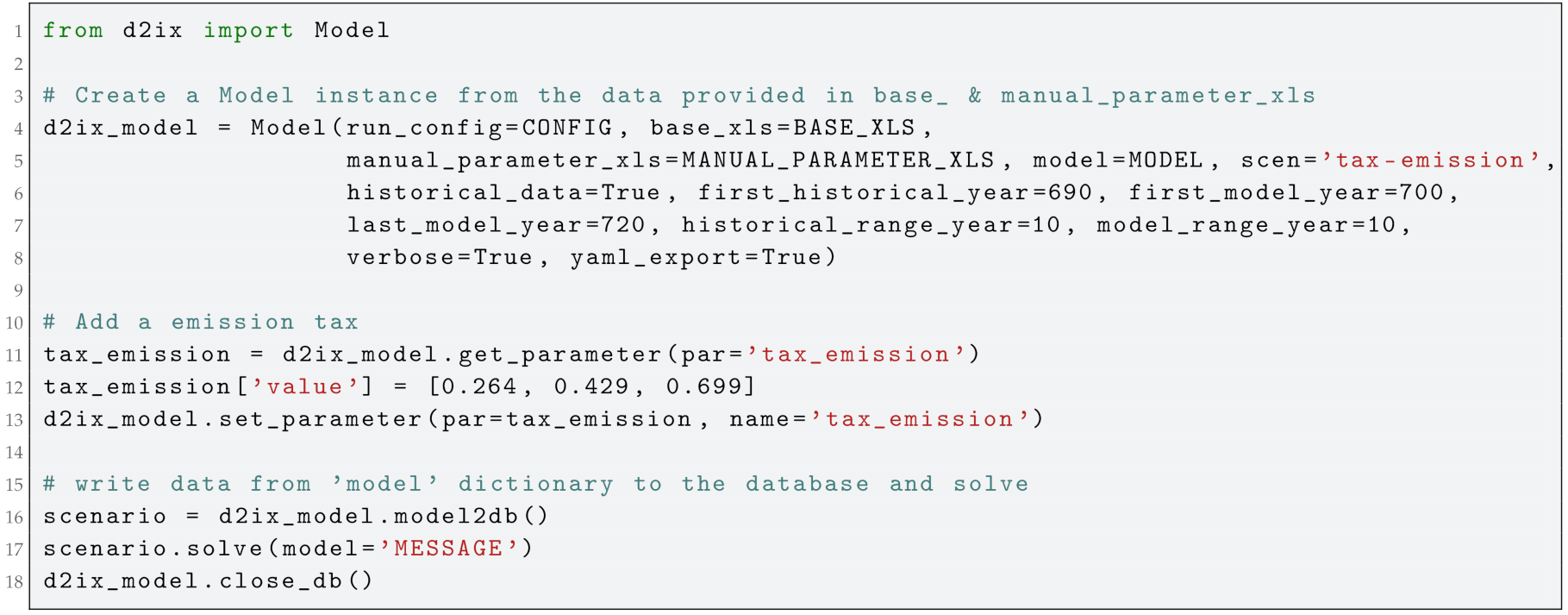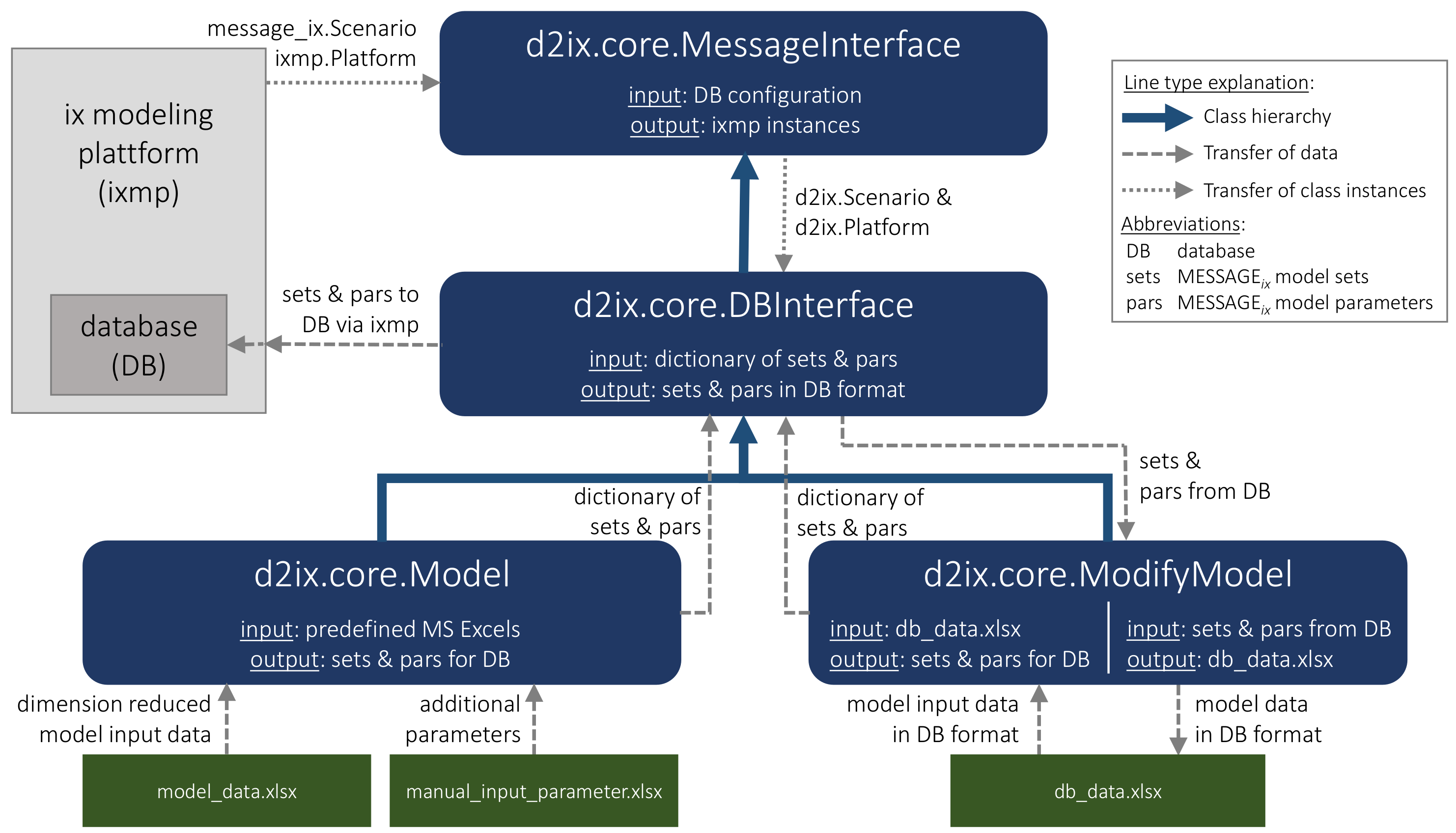d2ix: A Model Input-Data Management and Analysis Tool for MESSAGEix
Abstract
:1. Introduction
1.1. Input-Data-Handling—The Underrated Modelling Challenge
1.2. d2ix—Combining Benefits of Non-Binary and Binary Data Formats
2. Related Work
- Type I—Reduced text-file structures: The input-data of such models is handled in several long or one single, even longer, structured text-file. Such text-file-based input-data systems used to find application with most energy-system models. Due to their long history as well as their suitability for synoptic change-tracking, some modellers still rely on Type I input-data-handling strategies (e.g., Calliope [14]).
- Type II—Full parameter text-files: The input-data handled by this type is organised in a multitude of text-files. Each file contains one parameter in full dimension and shape as required by the database. Despite the low lucidity and the difficulty in tracking any (un-)intentional changes made to the input-data, Type II data-handling schemes are commonly used. Especially community-friendly, open-source models such as PyPSA [15] and oemof [16] in particular appreciate the high flexibility of the input-data-handler in combination with the low requirements regarding the programming skills of the modeller.
- Type III—Reduced parameter spreadsheets: Here the input-data is organised in MS Excel spreadsheets in reduced dimension. While this dimension reduction increases the lucidity of the input-data, it can at the same time limit flexibility. However, in order to lower barriers to entry for new modellers, several open-source models such as urbs [17] and ficus [18] rely on Type III input-data structures.
- Type IV—Code-based input-data: Code-based input-data can be either hard-coded or predefined and processed in functions. Thus, the input-data is documented and stored together with the code. Such transparent data-handling types allow for the full documentation of code and input-data within one workflow. However, extensive amounts of hard-coded data, can become overwhelming for any new user, just like the text-file-based data. Nevertheless, several renowned models such as MESSAGEix [8], Temoa [19] and OSEMOSYS [20] provide interfaces for hard-coded model input-data.
3. Methodology
3.1. Class Structure and Definition
3.1.1. MessageInterface—Communication with the Ix Modelling-Platform
3.1.2. DBInterface—Data-Handling in d2ix
3.1.3. Model—Data Transformation from Reduced Spreadsheet to Database Format
3.1.4. ModifyModel—From Database to Spreadsheet and Back
3.2. Testing and User Experience
4. Tutorial
4.1. Installation
4.2. Running d2ix—Creating a Model from Scratch
| Listing 1: Defining the d2ix model-creation parameters. |
 |
4.2.1. Creating a Model Instance
| Listing 2: Creating a new MESSAGEix scenario using the d2ix spreadsheet templates. |
 |
4.2.2. Transferring a Scenario from d2ix to the Database—model2db()
4.2.3. Solving a Scenario
4.2.4. Modifying the Input-Data—get_parameter(), set_parameter()
| Listing 3: Creating a MESSAGEixscenario—with a carbon tax—using the d2ix get_parameter() and set_parameter() approach. |
 |
4.3. Running d2ix— Modifying Existing Models
4.3.1. Creating a ModifyModel Instance
4.3.2. From Database to ModifyModel Instance & Excel Sheet—scen2xls()
4.3.3. From the Excel File to ModifyModel Instance—xls2model()
| Listing 4: Modifying an existing MESSAGEix model using spreadsheet inputs. |
 |
4.4. Post-Processing a MESSAGEix Scenario
5. Conclusions
Author Contributions
Funding
Conflicts of Interest
References
- Schrattenholzer, L. The Energy Supply Model Message; Number 81-31 in Research Report; OCLC: 254145200; International Institute for Applied Systems Analysis (IIASA): Laxenburg, Austria, 1981. [Google Scholar]
- Messner, S.; Schrattenholzer, L. MESSAGE–MACRO: Linking an energy supply model with a macroeconomic module and solving it iteratively. Energy 2000, 25, 267–282. [Google Scholar] [CrossRef]
- Koomey, J.; Berard, S.; Sanchez, M.; Wong, H. Implications of Historical Trends in the Electrical Efficiency of Computing. IEEE Ann. Hist. Comput. 2011, 33, 46–54. [Google Scholar] [CrossRef]
- Messner, S.; Strubegger, M. The energy model MESSAGE III. In Advances in Systems Analysis: Modelling Energy-Related Emissions on a National and Global Scale; Hake, J.F., Kleemann, M., Kuckshinrichs, W., Martinsen, D., Walbeck, M., Eds.; Konferenzen des Forschungszentrums Juelich: Juelich, Germany, 1994. [Google Scholar]
- Huppmann, D.; Rogelj, J.; Kriegler, E.; Krey, V.; Riahi, K. A new scenario resource for integrated 1.5 °C research. Nat. Clim. Chang. 2018, 8, 1027–1030. [Google Scholar] [CrossRef]
- Fricko, O.; Havlik, P.; Rogelj, J.; Klimont, Z.; Gusti, M.; Johnson, N.; Kolp, P.; Strubegger, M.; Valin, H.; Amann, M.; et al. The marker quantification of the Shared Socioeconomic Pathway 2: A middle-of-the-road scenario for the 21st century. Glob. Environ. Chang. 2017, 42, 251–267. [Google Scholar] [CrossRef]
- Baker, T.; Asim, M.; Tawfik, H.; Aldawsari, B.; Buyya, R. An energy-aware service composition algorithm for multiple cloud-based IoT applications. J. Netw. Comput. Appl. 2017, 89, 96–108. [Google Scholar] [CrossRef]
- Huppmann, D.; Gidden, M.; Fricko, O.; Kolp, P.; Orthofer, C.; Pimmer, M.; Kushin, N.; Vinca, A.; Mastrucci, A.; Riahi, K.; et al. The MESSAGE Integrated Assessment Model and the ix modeling platform (ixmp): An open framework for integrated and cross-cutting analysis of energy, climate, the environment, and sustainable development. Environ. Model. Softw. 2019, 112, 143–156. [Google Scholar] [CrossRef]
- Wilkinson, M.D.; Dumontier, M.; Aalbersberg, I.J.; Appleton, G.; Axton, M.; Baak, A.; Blomberg, N.; Boiten, J.W.; da Silva Santos, L.B.; Bourne, P.E.; et al. The FAIR Guiding Principles for scientific data management and stewardship. Sci. Data 2016, 3, 160018. [Google Scholar] [CrossRef] [PubMed]
- Reinhart, C.M.; Rogoff, K.S. Growth in a Time of Deb—Errata. Am. Econ. Rev. 2010, 100, 573–578. [Google Scholar] [CrossRef]
- Pfenninger, S. Energy scientists must show their workings. Nature 2017, 542, 393. [Google Scholar] [CrossRef] [PubMed]
- Pfenninger, S.; Hirth, L.; Schlecht, I.; Schmid, E.; Wiese, F.; Brown, T.; Davis, C.; Gidden, M.; Heinrichs, H.; Heuberger, C.; et al. Opening the black box of energy modelling: Strategies and lessons learned. Energy Strategy Rev. 2018, 19, 63–71. [Google Scholar] [CrossRef]
- Cao, K.K.; Cebulla, F.; Vilchez, J.J.G.; Mousavi, B.; Prehofer, S. Raising awareness in model-based energy scenario studies—Transparency checklist. Energy Sustain. Soc. 2016, 6. [Google Scholar] [CrossRef]
- Pfenninger, S.; Pickering, B. Calliope: A multi-scale energy systems modelling framework. J. Open Source Softw. 2018, 3, 825. [Google Scholar] [CrossRef]
- Brown, T.; Hörsch, J.; Schlachtberger, D. PyPSA: Python for Power System Analysis. J. Open Res. Softw. 2018, 6. [Google Scholar] [CrossRef]
- Hilpert, S.; Kaldemeyer, C.; Krien, U.; Günther, S.; Wingenbach, C.; Plessmann, G. The Open Energy Modelling Framework (oemof) - A new approach to facilitate open science in energy system modelling. Energy Strategy Rev. 2018, 22, 16–25. [Google Scholar] [CrossRef]
- Dorfner, J. Open Source Modelling and Optimisation of Energy Infrastructure at Urban Scale. Ph.D. Thesis, Technical University of Munich, Munich, Germany, 2016. [Google Scholar]
- Atabay, D. An open-source model for optimal design and operation of industrial energy systems. Energy 2017, 121, 803–821. [Google Scholar] [CrossRef]
- Decarolis, K.H.S.S.J.F. Modeling for insight using Tools for Energy Model Optimization and Analysis (Temoa). Energy Econ. 2013, 339–349. [Google Scholar] [CrossRef]
- Howells, M.; Rogner, H.; Strachan, N.; Heaps, C.; Huntington, H.; Kypreos, S.; Hughes, A.; Silveira, S.; DeCarolis, J.; Bazillian, M.; et al. OSeMOSYS: The Open Source Energy Modeling System. Energy Policy 2011, 39, 5850–5870. [Google Scholar] [CrossRef]
- Latte, B.; Henning, S.; Wojcieszak, M. Clean code: On the use of practices and tools to produce maintainable code for long-living. In Proceedings of the Workshops of the Software Engineering Conference 2019, Stuttgart, Germany, 18 February 2019. [Google Scholar]
- Orthofer, C.L.; Huppmann, D.; Krey, V. South Africa After Paris—Fracking Its Way to the NDCs? Front. Energy Res. 2019, 7, 20. [Google Scholar] [CrossRef]
- International Institute for Applied Systems Analysis (IIASA). The MESSAGEix Framework Documentation. 2018. Available online: http://messageix.iiasa.ac.at (accessed on 8 April 2019).
- International Institute for Applied Systems Analysis (IIASA). The MESSAGEix Framework. 2018. Available online: https://github.com/iiasa/message_ix (accessed on 8 April 2019).






| Type I | Type II | Type III | Type IV | d2ix | |
|---|---|---|---|---|---|
| (Git) change-tracking | yes | no | no | yes | yes |
| Synoptic data presentation | no | no | yes | no | yes |
| Parameter dimension reduction | no | no | yes | partly | yes |
| Sub-horizon parameter adaptation | yes | yes | no | yes | partly |
| Usable without programming knowledge | no | yes | few | no | yes |
| Dynamic scenario documentation | no | no | no | no | yes |
| Easy result visualisation | no | no | no | no | yes |
| Nodes | Technologies | Historical Periods | Model Periods | Runtime in sec. * | |
|---|---|---|---|---|---|
| Test Model 1 | 2 | 51 | 5 | 8 | 171 |
| Test Model 2 | 4 | 88 | 65 | 8 | 657 |
| Test Model 3 | 16 | 698 | 5 | 8 | 2291 |
| Parameter | Description |
|---|---|
| run_config | the path to the run_config.yaml file located in the config folder 1 The file contains the specifications of the database type. |
| base_xls | the path to the model_data file, located in the input folder 2 MS Excel file consists of seven input sheets that contain all necessary information for the model creation. Thus, the demand, the units, the technologies, and the nodes are defined and mapped in model_data. The structure of the file must to remain unchanged, as the input-data expansion done by d2ix depends on the current structure. |
| manual_input_parameter | all possible parameters, such as economic parameters and ecological constraints, can be added to the model using the manual_input_data file It provides the option of adding parameters manually by adding a sheet by the name of the parameter which contains the data in the format required by MESSAGEix. Thus, parameters in the manual_input_data are not manipulated by d2ix, but simply scanned for new set elements before being passed on to the database. |
| modelixmp | the name assigned to the model used as an identifier in the ixmp database |
| scenixmp | the name assigned to the scenario used as an identifier in the ixmp database |
| historical_data | allows the use of historical data |
| first_historical_year | defines the first historical year |
| first_model_year | defines the first model year If not assigned, it is set to the first year of demand. |
| last_model_year | defines the last model year If not assigned, it is set to the last year of demand. |
| historical_range_year | defines the the temporal resolution from historical data |
| model_range_year | defines the the model temporal resolution |
| verbose | defines the logger level in order to facilitate easy debugging |
| yaml_export | allows the export of yaml files from the model The model parameters and sets can be written to structured text-files before being added to the database in order to facilitate change-tracking (e.g., Git) despite the input-data being provided in xlsx format. This can be turned off during model calibration in order to increase speed. |
| Parameter | Description |
|---|---|
| xls_dir | the path to the directory where the MS Excel file will be saved |
| file_name | the name of the MS Excel that will be created or that the data will be read from |
© 2019 by the authors. Licensee MDPI, Basel, Switzerland. This article is an open access article distributed under the terms and conditions of the Creative Commons Attribution (CC BY) license (http://creativecommons.org/licenses/by/4.0/).
Share and Cite
Zipperle, T.; Orthofer, C.L. d2ix: A Model Input-Data Management and Analysis Tool for MESSAGEix. Energies 2019, 12, 1483. https://doi.org/10.3390/en12081483
Zipperle T, Orthofer CL. d2ix: A Model Input-Data Management and Analysis Tool for MESSAGEix. Energies. 2019; 12(8):1483. https://doi.org/10.3390/en12081483
Chicago/Turabian StyleZipperle, Thomas, and Clara Luisa Orthofer. 2019. "d2ix: A Model Input-Data Management and Analysis Tool for MESSAGEix" Energies 12, no. 8: 1483. https://doi.org/10.3390/en12081483
APA StyleZipperle, T., & Orthofer, C. L. (2019). d2ix: A Model Input-Data Management and Analysis Tool for MESSAGEix. Energies, 12(8), 1483. https://doi.org/10.3390/en12081483





